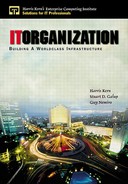General
| 1: | Why can't RAS flourish in client/server computing? |
| A1: | Client/server computing is like no other paradigm ever before in the history of computing. RAS will never flourish in this environment unless major focus is put on the proper design of the infrastructure. This means restructuring the organization and implementing a few very critical processes. And you need to implement metrics. We refer to it as building a world-class infrastructure. (See Chapter 7, Building a World-Class Infrastructure.) |
| 2: | Our IT shop is always in a reactive mode—how do we get out of this situation? |
| A2: |
Every shop on the list of elite 40 was in a reactive mode with the same daily firefighting routine (in particular the System Administration staff). There was never any time for planning, system architecture, or analysis of new technology. We found that the cause of the reactive mode was a lack of predetermined, well-conceived processes, and infrastructure to support the people tasked with implementing them. In other words, there wasn't any proactive work done up front.
You can get out of this situation by structuring to focus on mission critical and not technology, implementing three levels of support, and setting up the processes and procedures outlined in our books Rightsizing the New Enterprise, Managing the New Enterprise, Networking the New Enterprise, and Building the New Enterprise. See also our 13 commandments in Chapter 7, Building a World-Class Infrastructure. IT shops need to establish and follow a set of methodologies—a common set agreed upon by the entire organization. |
| 3: | Can IT ever become a company's competitive advantage? |
| A3: | Yes, but for now, as that ageless perception goes, IT is costing the company millions and what are the users getting in return? The CEO has no idea how much waste is really occurring in IT. Oh, they see the bottom line but they have no idea how much of that bottom figure is waste. We estimate that as much as 20 percent is waste—you add it up when most IT budgets are in the multi-million range. IT needs to get its house in order before it can ever expect to become a competitive advantage. IT will need to invest time and resource to building a world-class infrastructure. |
| 4: | How long will it take to build a world-class infrastructure? |
| A4: | The first four steps will take at least six months to a year to do it right, and possibly longer. The approach we provide you in this book is the quickest way of getting there. See Chapter 7 on how to build that elusive world-class infrastructure. |
| 5: | Management is always threatening to outsource the entire infrastructure or parts of the infrastructure. Is there anything we can do? |
| A5: | There's a lot you can do but it takes a lot of work. In this day and age you need to document your services, know the cost of these services, and be able to benchmark your services against vendors providing these types of services. You need to be one step ahead of management. If you do your homework and get your house in order, your costs should be lower than the competition. So much for the talk. |
| 6: | Why is it so difficult to draw lines of information technology demarcation in a network computing environment? |
| A6: | The main reason is the training and backgrounds of the IT employees. We call them Cowboys (client/server) and Dictators (mainframe) and they learned the IT business in very different environments. This causes great difficulty when you start discussing the separation of technical areas of responsibility that used to be owned by one or the other group. For example, deciding that the desktop should be the responsibility of the network group, or that database administration will control all databases on all platforms, is not easy for those that never aligned work responsibilities this way. |
| 7: | How does the information technology department truly provide local flexibility and centralized control? |
| A7: | This can really be a difficult one. We strongly recommend that in the areas of data management (i.e., backup and recovery), network backup support be made available in as many places as possible. Using tape backup silos and high bandwidth networks, overnight backups is a cost justifiable technology. Network management, server management, and software distribution management (either Web programs or application downloads) can provide behind-the-scene control with limited big brother image. A simple offering such as tape backup, disaster recovery storage for remote sites that insist that they must manage their systems, can be a major step forward to obtaining this goal. |
| 8: | Can the IT department deliver projects on time? |
| A8: | Yes. But it requires a different approach to project management and work in general. There is a method created by the Avraham Y. Goldratt Institute that manages projects in a very different and successful way. The basic premise is to work on one thing at a time, don't multi-task, and complete as many things in parallel as possible. We recommend that you view http://www.goldratt.com for more information. |
| 9: | Is the IT department a support or strategic business function? |
| A9: | It is both in most organizational settings. The problem is that most organizations view the IT department as support, first and foremost. This can spell real disaster for an organization. Competitive advantage is more and more being defined by the use of information technology. Think strategic first, support second. The mind set change can do wonders for your organization. |
..................Content has been hidden....................
You can't read the all page of ebook, please click here login for view all page.
